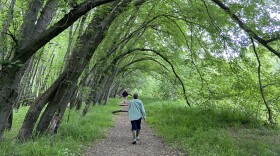Editor's note: We recommend you listen to this story, especially to enjoy the sound of the river!
Dave Anderson of the Forest Society has fished the Lane River in South Sutton for decades. He spent one morning on the banks of the Lane River with John Magee, of New Hampshire Fish and Game Department, to talk about how trout are made of trees. (Their conversation was inspired by the book “Trout Are Made of Trees” by April Pulley Sayre.)
Something Wild co-host Chris Martin of NH Audubon is out doing fieldwork.
For 20 years Magee was the fish habitat biologist at New Hampshire Fish and Game. He’s now the supervisor of the inland fisheries programs.
The Lane River is part of the upper watershed of the Merrimack River. It comes down Lion Brook from Kezar Lake and then flows through Sutton Mills, a former industrial village with waterfalls and water power. It then travels through South Sutton to the Warner River, all tributaries of the Merrimack.

Transcript
This has been lightly edited for length and clarity.
Dave Anderson: There are brook trout in this stream because it's cold and fast flowing. It also means we have a healthy crop of black flies in the neighborhood every year.
John Magee: Baby trout like to eat black flies as their first food. So, as annoying as they can be for us, they're pretty much vital for brook trout and other fish species as well.
Actually, there's a more technical term for baby trout: young of year. But that takes a lot to say. And it doesn’t sound as interesting, right? Who doesn't love babies?
Dave Anderson: I was watching some dragonflies or damselflies laying eggs on the pool right here. They're coming down, touching on the water, laying eggs and flying back up in the air. So there's a lot of insect activity. And that's what drives the whole thing. We tend to think of it as a trout stream, but it's really an insect stream.
John Magee: Right, it's an insect stream. What I think is so cool about this one spot here is it illustrates how important diversity is in our stream systems, just in terms of the flow of the water, the size of the rocks or the sand, and how it creates the habitat for fish and insects in the stream.
It’s absolutely vital for them to have that diversity of that habitat and those flows. And it's just a perfect example: there's a riffle, there's a pool, there's a riffle, there's a pool.
A riffle is a fast flowing section of a stream or river. A lot of times you'll see the surface is broken. You can hear it right now. There's bubbles oxygenating the water.

Dave Anderson: So we don't think about the trees. Well, I do all the time! But people who think about fish or aquatic invertebrates aren't thinking about the contribution of the trees. They feed the food chain with leaves that get shredded up and turned into food, and then also provide the shade keeping the water temperature cool.
And then the third thing is just that material, like branches, sticks, whole tree trunks that fall in — they slow the stream down and create that riffle and pool habitat that's ideal for growing little fish into big fish.
John Magee: Absolutely. And all those leaves start the basis of the bacteria to insect to other animals' food web. All those leaves, if they don't get retained here by natural wood or other features in the stream, where do they go? They just go downstream, somewhere else.
Leaves, branches, logs and entire trees, roots from the trees, all of that - when it comes to wood and streams, that wood is as natural to a stream as the water. And it should be there. It's supposed to be there.
An interesting thing that a lot of people have researched. I have, and my colleagues in New Hampshire have done this too. If you have very little wood in a brook trout stream, you tend to have fewer brook trout. They also tend to be smaller.
Another way to say it is the more wood in a stream, the more trout and the bigger they get.

If you want to know more about freshwater fishing in New Hampshire, check out New Hampshire Fish and Game.











